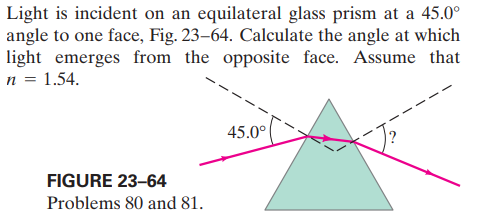Suppose a ray strikes the left face of the prism in Fig. 23–64 at 45.0° as shown, but is totally internally reflected at the opposite side. If the apex angle (at the top) is 0 = 65.0°, what can you say about the index of refraction of the prism? Light is incident on an equilateral glass prism at a 45.0° angle to one face, Fig. 23–64. Calculate the angle at which light emerges from the opposite face. Assume that n = 1.54. 45.0° FIGURE 23-64 Problems 80 and 81.
Suppose a ray strikes the left face of the prism in Fig. 23–64 at 45.0° as shown, but is totally internally reflected at the opposite side. If the apex angle (at the top) is 0 = 65.0°, what can you say about the index of refraction of the prism? Light is incident on an equilateral glass prism at a 45.0° angle to one face, Fig. 23–64. Calculate the angle at which light emerges from the opposite face. Assume that n = 1.54. 45.0° FIGURE 23-64 Problems 80 and 81.
Related questions
Question

Transcribed Image Text:Suppose a ray strikes the left face of the prism in Fig. 23–64
at 45.0° as shown, but is totally internally reflected at the
opposite side. If the apex angle (at the top) is 0 = 65.0°,
what can you say about the index of refraction of the prism?

Transcribed Image Text:Light is incident on an equilateral glass prism at a 45.0°
angle to one face, Fig. 23–64. Calculate the angle at which
light emerges from the opposite face. Assume that
n = 1.54.
45.0°
FIGURE 23-64
Problems 80 and 81.
Expert Solution
This question has been solved!
Explore an expertly crafted, step-by-step solution for a thorough understanding of key concepts.
This is a popular solution!
Trending now
This is a popular solution!
Step by step
Solved in 4 steps
